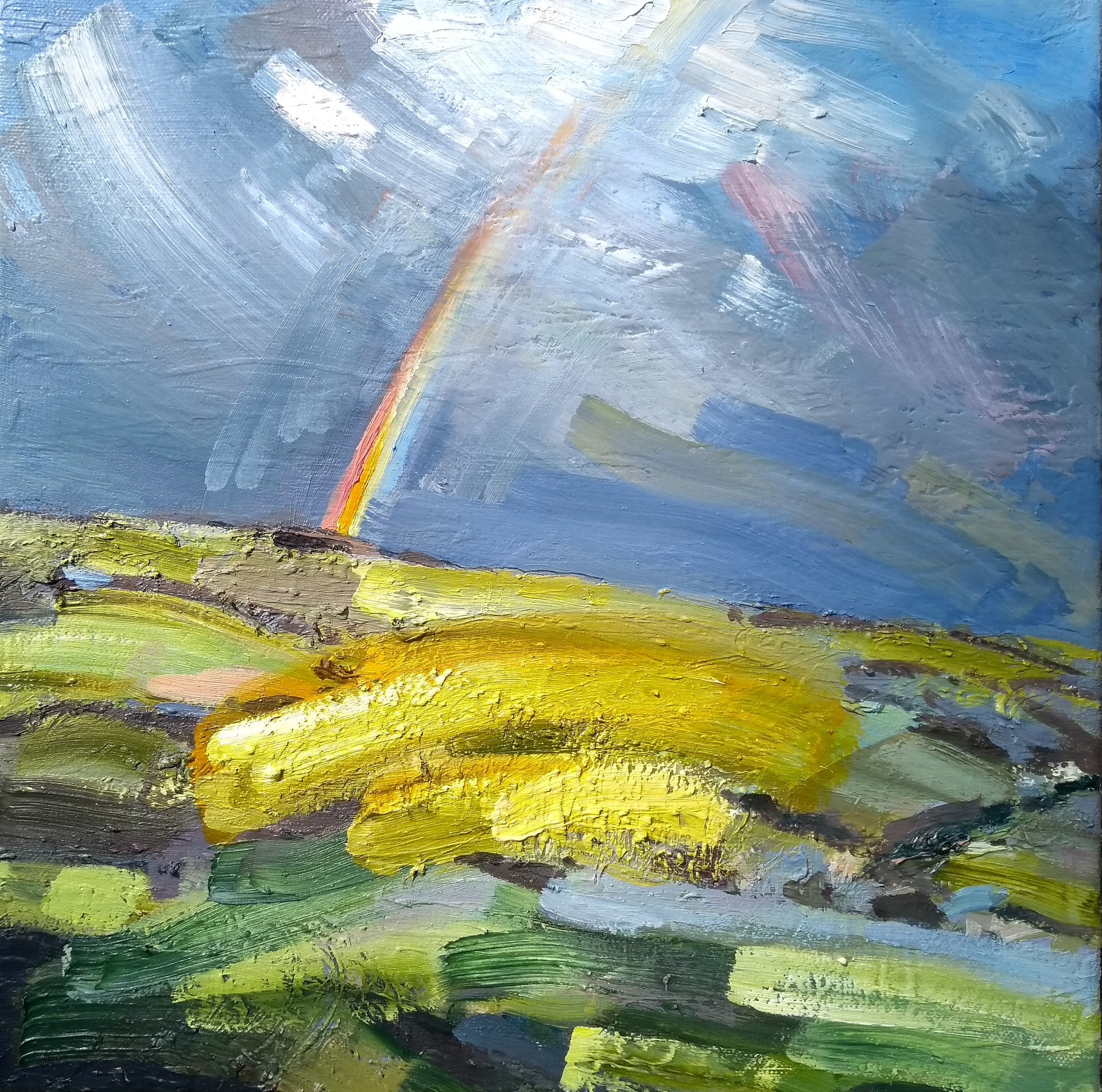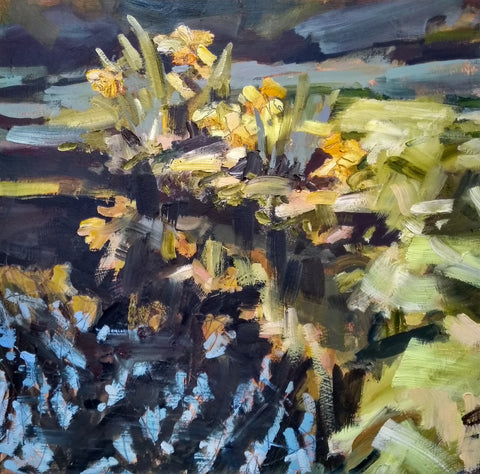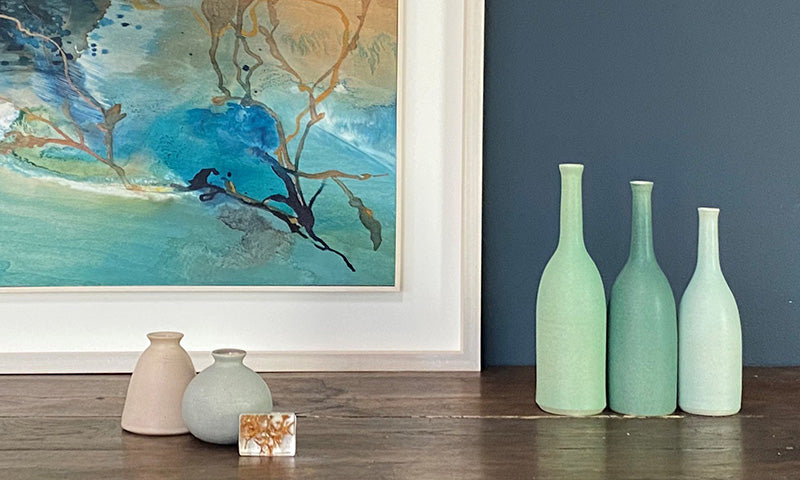A Colour Filled Life

Jill Hudson has long been a favourite at the Byre Gallery and her stunning landscapes and still lives regularly feature in our exhibitions throughout the year.
A graduate in Fine Art from Falmouth College of Art, Jill lives and works in rural south east Cornwall surrounded by beautiful countryside, a great source of inspiration. Living on the doorstep of the Rame Peninsula means Jill can also indulge her passion for capturing seascapes - and going sea swimming.
It’s lovely to have you back in the gallery with a new collection of work. How has the past year affected you?
In the lockdowns, I've been plein air painting within a walk from home, which means rivers, fields and hedgerows. It has been really good to focus on all things in my vicinity, because often they get passed by for the lure of the coast path. I am really very lucky to be where I am, there is a lot of inspiration in the landscape.


Do you have a typical day?
Pretty much! I start in the studio at 8am with lots of coffee and Classic FM. I always have paintings that I’m working on, it helps to have a good think in front of them before getting going. Working is not always painting, it’s figuring out what’s happening in the painting – what’s going well, what’s going wrong, what colours might work here or there. Sometimes things just fit together, other times I could end up painting over and over until it gets to an end point.
I generally paint for a few hours and then go for a quick walk if I need some inspiration. Fields and hedgerows are not far from the studio, there’s always something to spark the imagination. I go out and sketch, as this kind of loosens you up for painting too, helps to put a bit of immediacy into the studio work. Why am I not just going out and painting the fields and hedgerows? Often I do, but then there are deadlines for framing or for exhibitions, then there are drying times. Oil takes longer to dry, generally about a week – depending on the weather. Some colours like yellow, white and red take longer.
A studio day will be 8 – 5pm. In the winter I often work later – I have the fire on and lots of caffeine – sometimes if the mood takes me I might work late into the night. 2am is not unheard of. It’s not necessarily wall to wall work, but then sometimes it can be if I’m on a roll. I do have a couch in the studio if I nod off for a bit!
During your degree at Falmouth College of Art you spent three months studying at the Accademia di Belli Arti in Venice. What was that experience like at?
Venice – I love it there, spending time there as a student was such a luxury – it becomes home. Learning Italian (although still only mediocre at it) made me feel like I was actually there rather than just visiting. A beautiful, quirky city, fascinating – as it is like a step back through history. It cemented a severe coffee habit in me! I think it inspired me full stop, not only towards my art. The colour and light can be beautiful.
I am often drawn back – any excuse - and will look forward to it when we're allowed to travel again. There is a wonderful shop there that sells dry pigments and I always buy some to bring back with me. I love the names – how could you not buy Venezia Giallo ( Venetian Yellow) or Ercolano Blue (from a town near Pompeii, a lesser known victim of the ancient earthquake).
I'm sure you're missing travelling as it's been a big part of your life and painting practice. Now that we're all forced to be armchair travellers, please share some of your travels with us and and how those experiences have shaped your work?
Travel inspires and educates me. I take my sketchbook, draw in the front and write thoughts and a kind of journal in the back. I try and learn a bit of the language. I have been to wonderful and amazing places and feel very privileged, travelling on a shoestring or working alongside a voluntary organisation.
I love the landscape and so I walk, explore, experience it. I love the sea and sea-swimming (although often bloody cold) and I’ve been very lucky to crew for friends and sail to some amazing places. It all connects you more with what you’re trying to paint. My longest non-stop sailing passage was in 2019 and 11 days at sea when we sailed to Svalbard. It’s quite a feeling to be so far from land that all you see is sea and sky. Watching the sea, ever changing, ever moving with the tides, non stop, since time began – it blows my mind and I try to describe that on canvas. If I wasn’t a painter I’d have to write about it.
How has travel shaped my work? Informing it and exciting it all the time. At the same time it can be a stark reality. Svalbard is well up in the arctic. We were surrounded by glaciers that came down to the sea. All of which you can see from the kind of ‘tide lines’ on the rock beside them, have shrunk to a shadow of what they were. On the sea chart we were sailing and anchoring in unchartered waters.. because they used to be under the glacier. It was really rather devastating.

One memorable painting day on Tregantle beach I was watching an amazing sky and trying to capture it quickly. Luckily I had taken full waterproofs with me! Slowly it dawned on me why the sky was so amazing – it was about ready to open up and deluge – so, quickly on with the waterproofs, paints back in the box, there was nowhere to go so there I sat on the sand while it just heaved down… the only one on the beach. It was so ridiculous I just had to laugh! It didn’t last too long and then I just carried on with the painting. Of course, now it was a completely different one. Painting skies!

Do you work in sketchbooks and notebooks prior to painting, from photographs or memory?
Sometimes when I’m back in the studio I paint straight from my sketchbook. I often write notes on my sketches to describe the colour. In paint I try to capture the immediacy of the drawing – made outside – with the memory of the colours, or sometimes I’m playing with the colours to create a certain mood or a certain palette. Sometimes I’m inspired by the colour combinations, say in my pile of clothes in the washing pile, sometimes it’s the colours from a page in a magazine, sometimes the mauves and pinks and blue greens I see in an evening landsape when I’m out and about, will end up in my seascapes.
I take a lot of photographs, sometimes you just can’t paint quick enough to get the sky burst or the light going down. I use them for inspiration and information. I love the impressionists…they were my first love. I’m very lucky I have the camera as a tool to take that snapshot, but then you see it’s limitations also – the colours on the camera image aren’t the same as what you see with your eyes. In the end, the real thing is the amazing bit and my painting is a translation. My response to it.
You mention that you buy dry pigment in Venice, for the non-artists among us please tell us a little more about the steps behind this process and what you think this adds to your work?
I’ve also painted fresco – preparing a panel in this case with three layers of plaster, the final one the smoothest layer, then painting into that whilst still damp with dry pigments mixed with distilled water. You have to finish before the plaster goes hard. The paint is ‘caught’ in the surface of the lime plaster. This really is the painting method for longevity. You can still see some of the frescos at Pompeii. You have to paint in a very different way to oils, more like planned watercolour, but it’s always good to challenge yourself and look at or do things differently.
Mixing my own paints fascinates me, kind of gets me into the mechanics of the paint itself. Predominantly I still paint from the tube, but it’s just so satisfying to make it yourself. I’m sure the novelty would wear off if I had to do it all the time. Tube paints have meant that artists can paint more quickly in oils, be more connected with painting the image than the practicalities of mixing – and of course paint outside.


